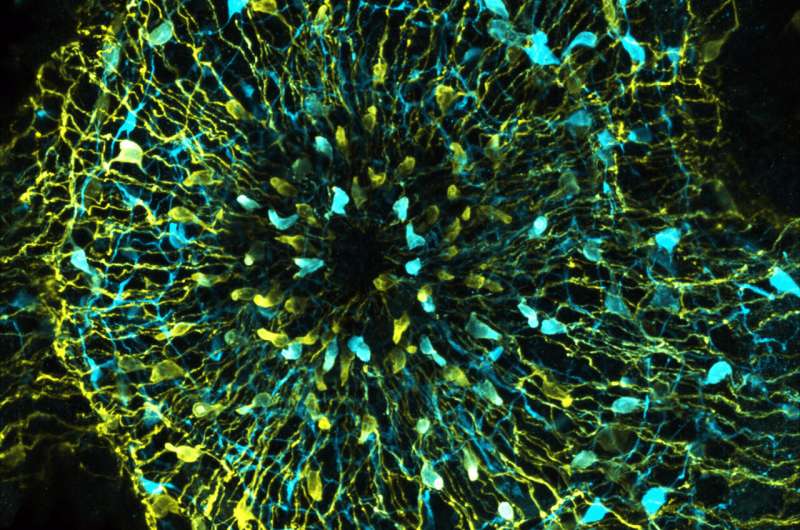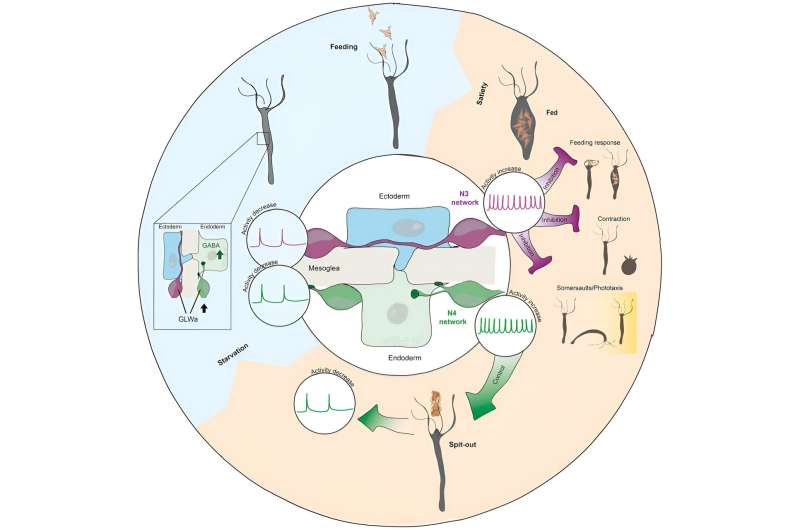This article has been reviewed according to Science X's editorial process and policies. Editors have highlighted the following attributes while ensuring the content's credibility:
fact-checked
peer-reviewed publication
trusted source
proofread
Researchers reveal evolutionary origins of appetite by studying simple nervous system of Hydra

Over the course of evolution, living organisms have gradually developed more complex nervous systems in order to coordinate increasingly complex sensory, motor and cognitive functions and to control the associated behavior.
Recently, different research projects have shown that even simple creatures with diffuse nervous systems can exhibit complex neuronal behavior, for example the processing of visual signals or so-called associated learning.
Researchers from the Cell and Developmental Biology group at the Institute of Zoology at Kiel University are studying one such simple multicellular organism, the freshwater polyp Hydra.
In previous studies, the research team from the Collaborative Research Center (CRC) 1182 "Origin and Function of Metaorganisms" led by Professor Thomas Bosch found connections between the feeding behavior of Hydra and the neurons involved.
The researchers identified certain nerve populations of the freshwater polyp that control the animals' mouth opening, among other things. In a follow-up study, they observed that fed animals reacted differently to food stimuli and also showed reduced locomotion after feeding compared to starved individuals.
In a next step, the researchers now want to find out how the animals integrate a complex metabolic state such as satiety and change their behavior accordingly. In their study, the research team was able to prove that the nervous system of Hydra can actually "measure" the internal metabolic state.
They found out that Hydra has two specific and indirectly connected nerve populations whose activity changes depending on the feeling of satiety. Similar to the much more complex organisms of vertebrates, one nerve population is responsible for digestion and another for the integration of satiety and changes in behavior.
Taken together, these findings may hint at early stages of a centralized nervous system. The CRC 1182 research team, which is also active in the Collaborative Research Center 1461 "Neurotronics," published its new results in the journal Cell Reports.
Feeling of satiety in Hydra influences feeding and related behaviors
First, the researchers investigated the direct influence of food intake on the feeding behavior of Hydra. Animals that were fed with their natural food showed a limited reaction to food stimuli for up to eight hours afterwards and opened their mouths significantly more slowly or not at all.
In additional experiments, the research team observed further behavioral changes that were indirectly related to food intake. "For example, after feeding the animals, they showed a significantly lower attraction to light stimuli and an equally strong suppression of natural movement patterns.
"One possibility is that Hydra moves towards the light in search of food, performing a somersault-like locomotion. Therefore, the feeling of satiety inhibits these behavioral patterns, as fed animals temporarily do not have to search for food," says Dr. Christoph Giez, research associate in the Cell and Developmental Biology research group.

Activity of nerve cells depends on internal metabolic state
In the next step, the Kiel researchers investigated the question of how the neuronal control of these extensive behavioral patterns works and whether the "sensing" of the metabolic state can be detected in the activity of certain nerve cells.
"A specific nerve population in the outer tissue layer shows an increased frequency during feeding, regardless of whether there is still food in the body cavity or not. This activity decreases again over time until the animal returns to normal feeding behavior again," says Giez.
The activity of another nerve population in the inner tissue layer of the animals is determined by whether or not food is present in the animal's digestive tract. Their activation appears to be dependent on mechanical stimulation by the food components.
The researchers carried out further functional experiments to investigate a connection between the activity of these two nerve populations in the so-called endoderm and ectoderm and animal behavior depending on their satiety.
When they experimentally removed the neurons in the ectoderm, the animals lost the ability to locomote and orientate towards light. The endodermal nerve cells, on the other hand, are directly related to food intake and excretion.
"We could thus deduce that the ectodermal population is mainly responsible for locomotion and for the integration of stimuli," says Giez. "By demonstrating this sub-functionalization of neurons in a simple system, we were able to show that certain nerve populations in Hydra can already assume central functions similar to those in more complex nervous systems."
Nerve populations involved in feeding behavior release inhibitory neuropeptides
Finally, the research team investigated whether certain peptides or neurotransmitters associated with feeding behavior are produced to different degrees in starved and satiated hydras.
"We found that a certain neuropeptide is significantly downregulated in satiated animals. It was already known that this neurotransmitter is also involved in controlling the somersault-like locomotion of the animals, contractions, and regulating satiety in other Cnidarians," says Giez.
It is possible that this peptide, which is only produced by the nerve populations involved in feeding behavior, plays an important role in appetite regulation in Hydra, possibly by playing a role in the indirect communication between the inner and outer nerve populations.
Overall, the researchers from the CRC 1182 were thus able to trace the neuronal regulation of satiety in Hydra mainly to two nerve populations and their effects on a whole spectrum of feeding-related behavioral patterns.
"This proves that a very simple system such as the diffuse nerve network of the freshwater polyp is already capable of sensing something as complex as the internal metabolic state and can regulate the related behaviors accordingly.
"Based on these observations, we will be able to learn more about how this modulation works in more complex organisms and thus gradually learn more about the evolutionary origins of the feeling of hunger and its further development," says the head of the research group, Professor Thomas Bosch.
More information: Christoph Giez et al, Satiety controls behavior in Hydra through an interplay of pre-enteric and central nervous system-like neuron populations, Cell Reports (2024). DOI: 10.1016/j.celrep.2024.114210
Journal information: Cell Reports
Provided by Kiel University





















